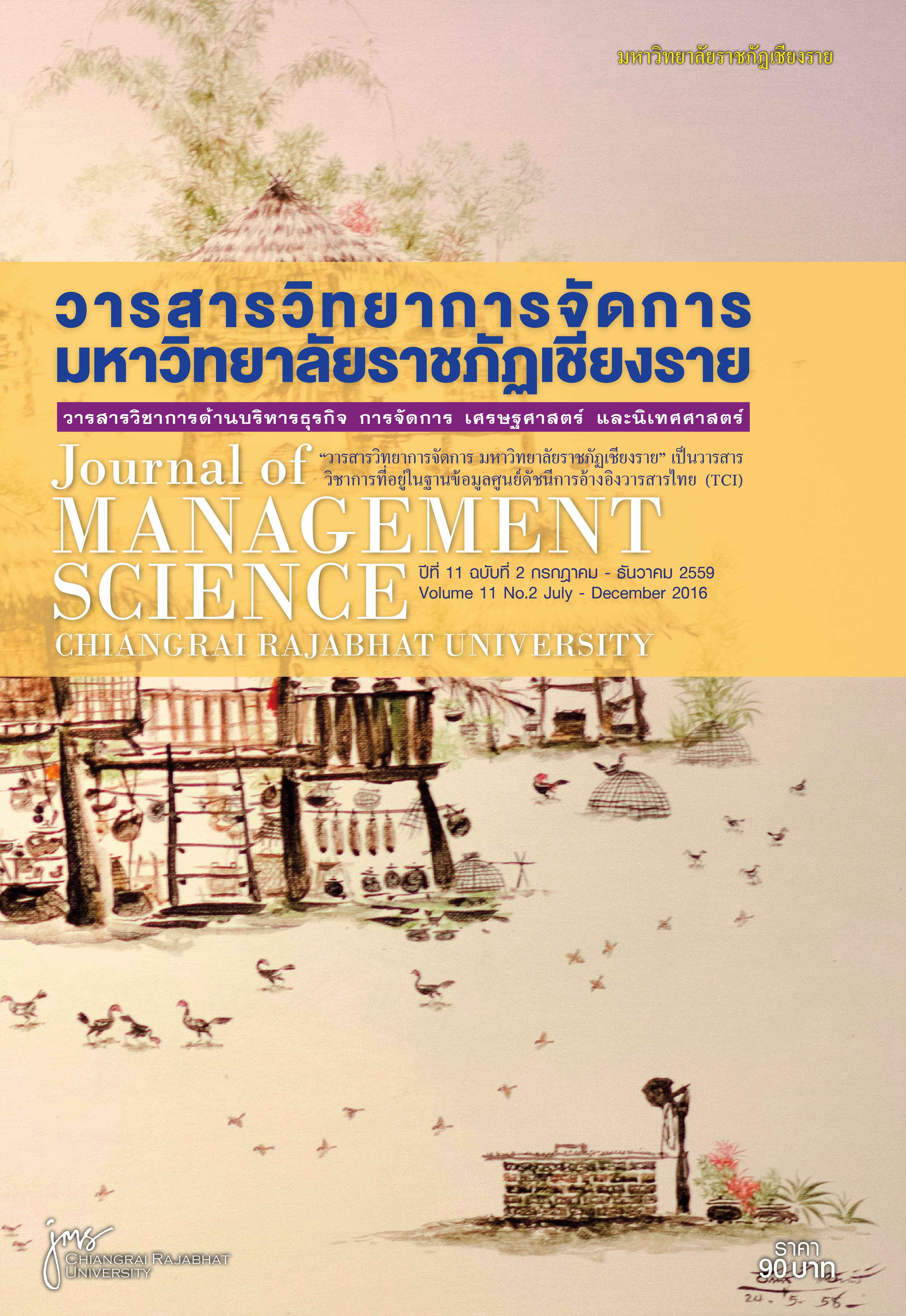The Relationship of Internal and External Factors Affecting Cassava’s Product Export to China
Main Article Content
Abstract
The objectives of this research were to examine the relationship between internal and external factors affecting cassava’s products export to China and to investigate the influence of internal and external factors forecasting to cassava’s products export to China. Secondary data was used in this research. They were quantity of cassava’s products export to China and the internal and external factors affecting quantity to export to China. The data was recorded in yearly and times series from 2006-2015. This study employed Multiple Regression Models and Ordinary Least Squares (OLS) in data analysis of Cassava’s Product exports to China based on time-series secondary data. The research results found that the most affecting factors was the Currency Exchange Rate which had the highest relationship with the cassava’s products export to China. If the rate of foreign exchange rate with US dollars increased, the volume of exports of cassava products to China would increase. .The followed affecting factors were the quantity of cassava’s product in Thailand, GDP and quantity of Vietnam's cassava exports to China.
Article Details
Views and opinions expressed in the journal do not necessarily reflect those of the editors.
References
จิตทิพย์ พึ่งอาศรัย. (2547). ผลจากการลดอัตราภาษีศุลกากรผลิตภัณฑ์มันสำปะหลังของประเทศสาธารณรัฐประชาชนจีนที่มีต่อการนำเข้าผลิตภัณฑ์มันสำปะหลังจากประเทศไทย. (วิทยานิพนธ์ปริญญาวิทยาศาสตร์มหาบัณฑิต (เศรษฐศาสตร์เกษตร). กรุงเทพฯ : บัณฑิตวิทยาลัย มหาวิทยาลัยเกษตรศาสตร์.
นราทิพย์ ชุติวงศ์. (2550). ทฤษฎีเศรษฐศาสตร์. (เอกสารวิชาการ). คณะเศรษฐศาสตร์ จุฬาลงกรณ์วิทยาลัย : ศูนย์บริการ.
นิฐิตา เบญจมสุทินและ นงนุช พันธกิจไพบูลย์. (2548). เศรษฐศาสตร์ระหว่างประเทศ. กรุงเทพฯ : สำนักพิมพ์แห่งจุฬาลงกรณ์มหาวิทยาลัย.
นิติยา สังขปรีชา. (2542). การวิเคราะห์ส่วนแบ่งตลาดส่งออกข้าวของไทยและข้าวสหรัฐอเมริกา. (วิทยานิพนธ์ปริญญา
วิทยาศาสตร์มหาบัณฑิต (เศรษฐศาสตร์เกษตร). กรุงเทพฯ : บัณฑิตวิทยาลัย มหาวิทยาลัยเกษตรศาสตร์.
บทที่ 7 การค้าระหว่างประเทศ. (2558). เอกสารอิเล็กทรอนิคส์. (ออนไลน์). แหล่งที่มา: www2.nkc.kku.ac.th/.../บทที่%207%20การค้าระหว่างประเทศ.doc สืบค้นเมื่อ 30 ธันวาคม 2558.
รัตนา ตันฑเทอดธรรม, ปฐมา จาตกานนท์ และยุพา ปานแก้ว. (2556). การวิเคราะห์ความต้องการของตลาดและการใช้ประโยชน์จากมันสำปะหลังในประเทศจีน. (รายงานการวิจัย). กรุงเทพฯ : มหาวิทยาลัยเกษตรศาสตร์.
วันรักษ์ มิ่งมณีนาคิน. (2552). หลักเศรษฐศาสตร์จุลภาค. กรุงเทพฯ : มหาวิทยาลัยธรรมศาสตร์.
ศิริประภา สุขสำโรง. (2557). ความสัมพันธ์ของปัจจัยภายในและปัจจัยภายนอกประเทศที่มีต่อการส่งออกยางพาราชนิดยางแผ่นรมควันชั้น 3 ไปประเทศจีน. (วิทยานิพนธ์ปริญญามหาบัณฑิต, มหาวิยาลัยเทคโนโลยีราชมงคลธัญบุรี)
สมาคมการค้ามันสำปะหลังไทย. (2559). ข้อมูลมันสำปะหลัง. สืบค้นจาก http://ttta-tapioca.org
สำนักงานการเงิน. โดยธนาคารแห่งประเทศไทย. (2559) สืบค้นจาก https://www.bot.or.th
อัครพงศ์ อั้นทอง (2550). เอกสารคู่มือการใช้โปรแกรม Eviews เบื้องต้น : สำหรับการวิเคราะห์ทางเศรษฐมิติ. เชียงใหม่ : สถาบันวิจัยสังคม มหาวิทยาลัยเชียงใหม่.
อัทธ์ พิศาลวานิช. (2554). ทฤษฎีและนโยบายการค้าระหว่างประเทศ. กรุงเทพฯ : คณะเศรษฐศาสตร์ มหาวิทยาลัยหอการค้าไทย.
สำนักวิจัยเศรษฐกิจการเกษตร. (2553). เอกสารข้อมูลพื้นฐานเศรษฐกิจการเกษตร ปี 2553. (ออนไลน์).
แหล่งที่มา: http://www.oae.go.th/download/download_journal/fundamation-2553.PDF สืบค้นเมื่อ 20 ธันวาคม 2558.
Tian Hui และ ชินาพัชร์ ราชบริรักษ์. (2557). “ความสามารถในการแข่งขันการส่งออกผลิตภัณฑ์มันสาปะหลังไทยไปยังสาธารณรัฐประชาชนจีน,” วารสารธุรกิจปริทัศน์. 6, 2 : 181-198.


